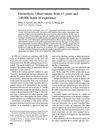An Approach to the Patient with Hirsutism

TLDR The document concludes with guidance for doctors on diagnosing and treating hirsutism effectively and safely.
The document from 2012 provides a review of hirsutism, an endocrinological condition characterized by excessive hair growth, which can range from a normal variation to a symptom of serious underlying conditions like adrenal adenocarcinoma. It discusses the physiology of normal hair growth in women, outlines common abnormal patterns, and presents a differential diagnosis for each pattern. The review describes a method for physicians to diagnose the causes of hirsutism and evaluates the available treatments, considering their risks and benefits. The focus is on guiding physicians towards an efficient, cost-effective, and safe clinical approach to managing patients with hirsutism.
